Clash of the Titans - TT Tai Chi vs. CM Stacker 830
by Joshua Buss on February 23, 2006 12:05 AM EST- Posted in
- Cases/Cooling/PSUs
Thermaltake Tai Chi
Thermaltake knows how to make a good case. This has been shown to be true time and time again both by our site and many others. A subdivision of theirs, Thermalrock, ran away with a gold editor's choice award in our large 8-way comparison for its excellent Eclipse case, and although never published, a close examination of their Armor case also bore out this claim as it is a fine unit capable of just about anything that one could ever want in a computer case. So, how does one improve upon cases as nice as the Armor and Eclipse, exactly? Well for starters, you don't remove any of the features that made the predecessors so popular.
Like the armor, the most prominent feature of the Tai Chi is the staggering number of externally available 5¼” drive bays – 11 to be exact. While there is one bay that's already assumed used for the 3½” drive/ power+reset buttons/LED indicators unit, it's still technically optional, as is the accessory tray and hard drive cage. Even with all three of these units in place, however, the Tai Chi could hold any of the following possible configurations: an additional six 5¼” drives; three 5¼” drives and an additional three hard drives; or two more hard drive cages for a total of nine hard drives. The storage options alone will be reason enough for some people to jump right on this unit. With this much capacity comes a price – and that price is size. The Tai Chi is massive.
Getting past the amazing drive capacity and size is just the beginning, however; the Thermaltake flagship case doesn't look like a giant radiator for nothing. Solid 1/8” think aluminum panels lining both sides absorb much of the computer's excess heat and passively vent it to the surrounding air.
The right side of the case, being almost entirely void of anything interesting, is even more monolithic in appearance than the left. To break up the monotony and give the case its own flair, Thermaltake uses two overlapping flaps to conceal the front drives.
The inner flap is anodized black, and when partially covered by the silver flap, helps to spice up the otherwise all-silver look and give the case a very stylish curved theme when viewed from the front. Besides simply looking cool, these over-sized half-doors should provide some decent protection considering their thickness, something that we questioned with the Armor's “flaps”. In addition to beefy door panels, the Tai Chi comes with two solid aluminum handles to help move the beast around, which are not even really optional anymore on a case this size. Nonetheless, they are a well-executed addition, and are completely removable if desired.
Here, we can take a closer look at the actual finish of the Tai Chi and the layout of the top of the unit. Notice how the paint job actually leaves the aluminum with a metallic speckled look. The pictures don't even really do it justice, as it almost comes across as a brilliant platinum more so than a normal silver anodization. The port cluster for the Tai Chi is on top, and unfortunately, it places all the ports very close to each other, but that's starting to become less and less of a problem as USB devices continue to shrink. With the USB, FireWire, and audio jacks so far back on the top of the unit, Thermaltake was locking themselves into users placing this case on the ground, but with a case this large, we don't think that many users would object to this restraint – this case would simply look out of place on top of most desks.
The left side of the Tai Chi is all business. Massive holes open the warmest area of the interior completely to the outside, while large aluminum fins do the rest of the work in terms of whisking away heat from the computer. The various visible screws are what hold the three individual panels in place, but can be taken out if work needs to be done on any panel.
Thermaltake knows how to make a good case. This has been shown to be true time and time again both by our site and many others. A subdivision of theirs, Thermalrock, ran away with a gold editor's choice award in our large 8-way comparison for its excellent Eclipse case, and although never published, a close examination of their Armor case also bore out this claim as it is a fine unit capable of just about anything that one could ever want in a computer case. So, how does one improve upon cases as nice as the Armor and Eclipse, exactly? Well for starters, you don't remove any of the features that made the predecessors so popular.
Like the armor, the most prominent feature of the Tai Chi is the staggering number of externally available 5¼” drive bays – 11 to be exact. While there is one bay that's already assumed used for the 3½” drive/ power+reset buttons/LED indicators unit, it's still technically optional, as is the accessory tray and hard drive cage. Even with all three of these units in place, however, the Tai Chi could hold any of the following possible configurations: an additional six 5¼” drives; three 5¼” drives and an additional three hard drives; or two more hard drive cages for a total of nine hard drives. The storage options alone will be reason enough for some people to jump right on this unit. With this much capacity comes a price – and that price is size. The Tai Chi is massive.
Getting past the amazing drive capacity and size is just the beginning, however; the Thermaltake flagship case doesn't look like a giant radiator for nothing. Solid 1/8” think aluminum panels lining both sides absorb much of the computer's excess heat and passively vent it to the surrounding air.
The right side of the case, being almost entirely void of anything interesting, is even more monolithic in appearance than the left. To break up the monotony and give the case its own flair, Thermaltake uses two overlapping flaps to conceal the front drives.
The inner flap is anodized black, and when partially covered by the silver flap, helps to spice up the otherwise all-silver look and give the case a very stylish curved theme when viewed from the front. Besides simply looking cool, these over-sized half-doors should provide some decent protection considering their thickness, something that we questioned with the Armor's “flaps”. In addition to beefy door panels, the Tai Chi comes with two solid aluminum handles to help move the beast around, which are not even really optional anymore on a case this size. Nonetheless, they are a well-executed addition, and are completely removable if desired.
Here, we can take a closer look at the actual finish of the Tai Chi and the layout of the top of the unit. Notice how the paint job actually leaves the aluminum with a metallic speckled look. The pictures don't even really do it justice, as it almost comes across as a brilliant platinum more so than a normal silver anodization. The port cluster for the Tai Chi is on top, and unfortunately, it places all the ports very close to each other, but that's starting to become less and less of a problem as USB devices continue to shrink. With the USB, FireWire, and audio jacks so far back on the top of the unit, Thermaltake was locking themselves into users placing this case on the ground, but with a case this large, we don't think that many users would object to this restraint – this case would simply look out of place on top of most desks.
The left side of the Tai Chi is all business. Massive holes open the warmest area of the interior completely to the outside, while large aluminum fins do the rest of the work in terms of whisking away heat from the computer. The various visible screws are what hold the three individual panels in place, but can be taken out if work needs to be done on any panel.


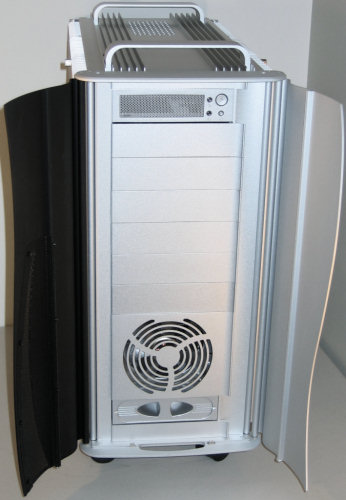
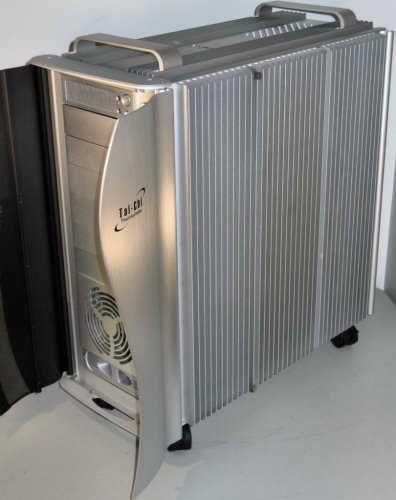
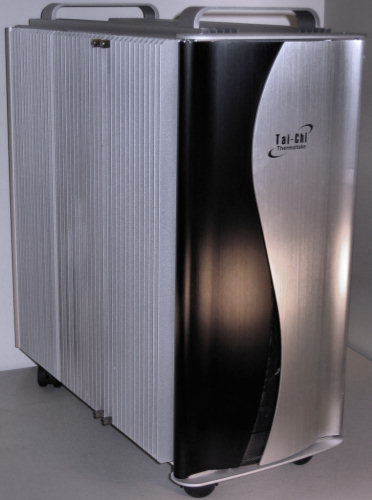
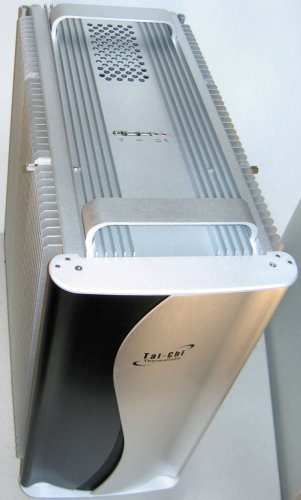
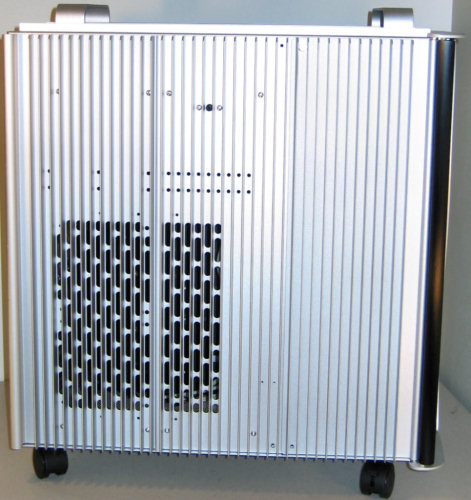








55 Comments
View All Comments
tscholz - Sunday, April 30, 2006 - link
As for cooling, these cases are some of the most stupid designs i have ever seen. What are all those meshes doing on the stacker, but ruining the cooling performance. The proper way to cool a case is by using vacuum, and not by sucking or blow huge amounts of air in and out from all directions. A case should have one air intake (might be a few smaller ones), and one output. Only one fan is needed on the output, since it creates the vacuum to suck new air in from the input intake(s).And as for the Tai Chi, no those fancy fans on the sides does not do much (if anything) for the cooling. The energy transfer rate from the air inside to the alu casing is very little, and does not match the effects of fresh air constantly moving through tha case. The only thing these fans will do, is to collect dust.
There is no doubt that the interior of these cases are cool then full of fans, but why use that many when you don't have to?! More fans equal more noise, and does not make it that much cooler.
For reference, my case has a total of 2 fans (3 if you count graphics), one in the PSU, and one in the back that cool CPU and keeps air flowing through the casing. I blocked off all those extra holes in the back and front, to make sure that the air flows past the HD's, over the chipset, through my Thermaltake Tower 112 (damn it's big), and finally blown out the back. At a room temp. at 23 °C, the interior and CPU temp is 32 °C idle (53 °C load).
seanp789 - Saturday, March 18, 2006 - link
alot fo people are wondering if these things really work and there are debates on both sides.I bought the case recently and have come to this conclussion.
A typical heatsink is in direct contact with the heat source. The tai chi case only comes in contact with air for the most part. Now there is no doubt that there is hot air inside your case. The longer your case is running at full load the more of an effect that hot air has on surrounding components. While its true that air is less conductive that a directly contact, the massive surface area the case provides as a heatsink is what allows it to be so effective.
For doubters, take this simple test I did. Use a blow dryer to heat the side of your case, then use a blow dryer on the tai chi case. you will find that the tai chi cools itself much faster than a normal case. While i didnt take exact temps I timed the dryer exposure time and relatively how long each case took to cool.
chynn - Thursday, March 2, 2006 - link
After you can mount an ATX motherboard in the motherboard tray, you can use either the left (normal) or right (inverted) case slots to insert the tray.You can relocate the four fan array to either side of the case.
You can change the side the front door is mounted to, which is great for left-handed people like me.
You have to screw down all components mounted in the 5.25in bays with the provided screws. The snap locks are there only for positioning and/or testing purposes.
The stock fans are noisy, sleeve bearing, and low MTBF units. Not good for this costly a case. OTOH, the fans in the ThermalTake might be just as bad ... :)
JoshuaBuss - Monday, May 15, 2006 - link
Actually the front door can't be turned upside down so that it opens the other way. I tried.. it doesn't fit.The snap locks work fine for permanent mounting...?
The stock fans I received are VERY quiet, even at 12v.
fsardis - Thursday, March 2, 2006 - link
do you even own the case? have you even heard the fans? FYI they are both inaudible and i speak from first hand experience cause i own the thing.just because it has a sleeve bearing doesnt mean its noisy.
Systemshocked - Wednesday, March 1, 2006 - link
I purchased an Armor case last year, and my one gripe about the case is the tool-less expansion card clamp (that green and purple thing in Anandtech's photos). It's flimsy, and it didn't fit with my Geforce 6800 GT video cards. So I removed it.So much worthless processed hydrocarbon in my opinion.
And I wouldn't trust it to hold my cards in place if you're planning on transporting the case anywhere.
My two cents.
seanp789 - Monday, February 27, 2006 - link
the specs measure the tai chi at 600mm or a little less than 2 feet. I woudl like to if height is measured with or without wheels and handles. because the clearance below my desk is right on the borderline and im afraid the handles will make it not fit.r33tr33t - Sunday, February 26, 2006 - link
Why doesn't AnandTech review the Zalman Totally No Noise Series?The TNN 500AF is more expensive than either of these cases and probably has competitive build quality.
Aikouka - Sunday, February 26, 2006 - link
I was wondering if you'd use some possible higher enthusiast (or just tests for plain looney people). What I mean by this is for example, I am in the market for a new case right now, because I currently have 5 HDDs in my Xaser III V2000A. I built a computer for a friend with a 7800GT SLi configuration and both of his video cards run 20C cooler than my single 6800GT (both being BFG OC cards). His 4800+ runs cooler than my 4400+ and I use a Thermalright XP90C with Arctic Silver V where he used the stuff that came in the box. So, yeah... thermals are why my games sometimes will mess up, but I'm not sure what cases are a good choice.Like I said, it's kind of leaning toward enthusiast/looney to do tests where you up the thermal anty, but there are people with multiple hard drives in their machines and for people in predicaments like mine (where their hard drives sit in front of their only intake fans), they're in quite the pickle.
chynn - Thursday, March 2, 2006 - link
So what case are you using, friend??? It would help if we knew ... :)For example, one of the reasons I am moving to the RC-830 is that my Lian-Li V1200 case does not cool the SLI graphics cards properly, so the whole case runs hot.
I have purchased the V1200 "Plus" cooling kit and some 120mm Scythe SFF21F fans though to remedy that problem.
The Lian-Li has an Asus A8N-SLI Deluxe, FX-55, 2x eVGA 6800GT 256M, 2x 74G WD Raptors and a hard drive in it.
The RC-830 will have a DFI LanParty UT Expert, FX-60, 2xeVGA 7800GTX ACS3, 2x 150G WD Raptors and a hard drive in it.
Both cases have a DVD reader/burner and a floppy drive in them.
From looking at the two cases, the RC-830 has the better cooling solution by far ... even after the Plus kit is installed in the Lian-Li.